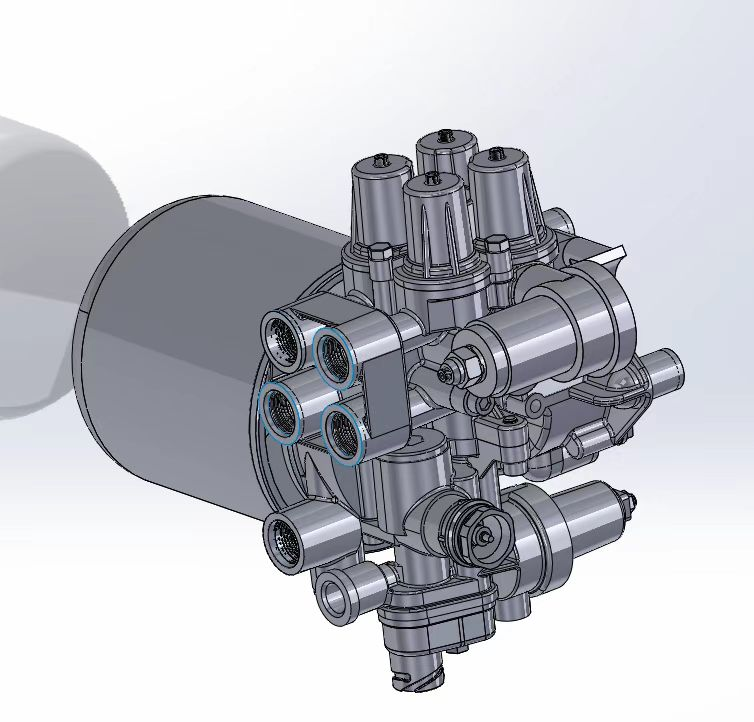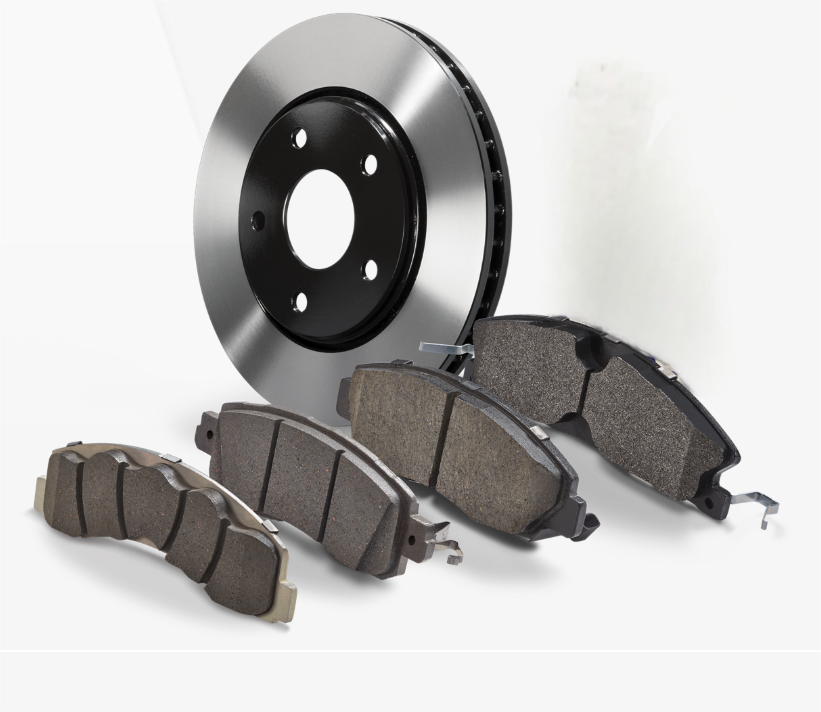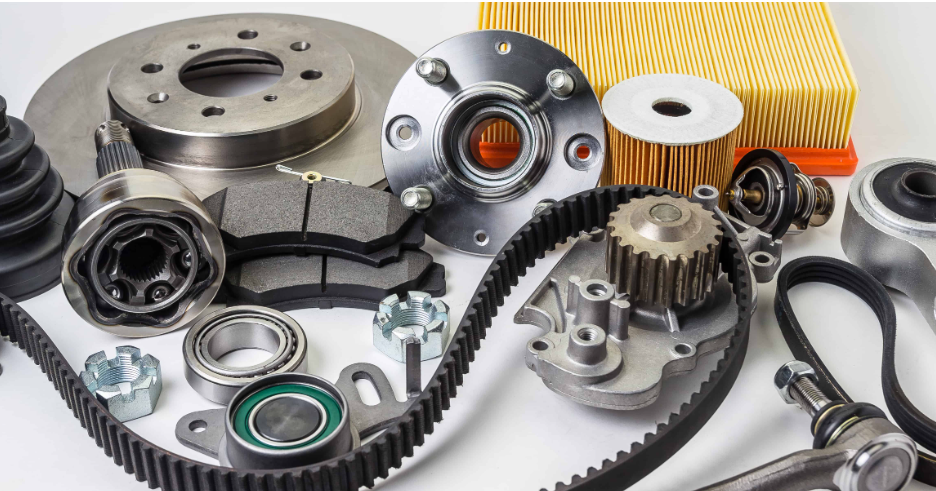Მასალის შეკრულობა ავტომობილური ჰაერის გადაცემის ხოზებისთვის
Რ椽ბერის კომპოზიციები სურვილისა და გამძლეობისთვის
Როდესაც საუბარი იწევს ავტომობილის კონდიციონერის მილების მოქნილობაზე და ხანგრძლივობაზე, გამოყენებული რეზინის ტიპი ყველაზე მნიშვნელოვან ფაქტორს წარმოადგენს. EPDM და NBR რეზინები ბაზარზე დომინირებენ, რადგან ამ პირობებში ისინი უმჯობინ მუშაობენ. ეს მასალები საკმარისად მდგრადია სიცხის ზეგავლენის, მზის დაზიანებისა და ოზონის განადგურების მიმართ, რაც ასახავს მექანიკოსების მიერ მათი არჩევანს ავტომანქანის ნაწილებისთვის. ყველაზე მნიშვნელოვანი ის არის, რომ ხარისხიანი რეზინა დროთა განმავლობაში არ დაიშლება, ამიტომ მილები ადრე არ იკვება ან არ იწვევს წყალგაშვის პრობლემებს. გარემოში ჩატარებულმა ტესტებმა აჩვენა, რომ ნამდვილი EPDM/NBR მილები იკვეთს იაფი ალტერნატივების ვიდრე მინიმუმ 30%-ით უფრო ხანგრძლივია, მკაცრ პირობებშიც კი, როგორიცაა მუდმივი ვიბრაცია ან გზის მარილის მიმართ გამოხატული გამძლეობა. ნებისმიერი ავტომობილის შენარჩუნებით დაკავებული ადამიანისთვის, სწორი რეზინის არჩევა არ არის მხოლოდ სპეციფიკაციების საქმე, ეს პირდაპირ გავლენას ახდენს იმაზე, რამდენად ხშირად მოხდება მისი შეცვლა.
Ტერმოპლასტური ელასტომერები ახალ ხოზის დიზაინებში
Თერმოპლასტიკური ელასტომერები, ანუ TPE-ები, როგორც ისინი ხშირად მოიხსენიებიან, მანქანების ხორცის წარმოებაში სულ უფრო პოპულარული ხდება, რადგან ისინი მრავალფეროვან მდგომარეობებში ძალიან კარგად მუშაობენ. ამ მასალების განსაკუთრებულობას უზრუნველყოფს ის, რომ ისინი შეიძლება რამდენიმეჯერ გამეორებით გადამუშაონ, გარდა ამისა, ისინი უფრო მეტად გრძელდებიან, ვიდრე ჩვეულებრივი რეზინის ვარიანტები. მათი კარგი შესრულების მიზეზი იმაში მდგომარეობს, თუ რაგან შედგებიან – ძირითადად პლასტმასისა და რეზინის მსგავსი რამის შერევა. ეს კომბინაცია უზრუნველყოფს მათ მანქანის სხვადასხვა რთულ პირობებში გამკლავებას, ხოლო მაინც იმდენად მოქნილები რჩებიან, რომ არ მოხდეს მათი გატეხვა ან გატეხვა. რამდენიმე კვლევის შედეგები აჩვენებს, რომ TPE-სგან დამზადებული ხორცი საერთოდ უკეთ მუშაობს, რაც ახსნის, რატომ უფრო მეტი ავტომობილის მწარმოებელი გადადის მათზე დროთა განმავლობაში. როგორც მრეწველობა მიდის უფრო მწვანე ამონახსნებისკენ, TPE წარმოადგენს გონივრულ არჩევანს, ვინაიდან ის აკმაყოფილებს გარემოსდაცვით მიზნებს იმ ხარისხის დაუშვებლობით, რაც საჭიროა სატრანსპორტო საშუალებების ნორმალური მუშაობისთვის.
Ნილონის ალოის ბარიერები წინადადების პრევენციაზე
Ნაილონის შენადნობის ბარიერებს მნიშვნელოვანი როლი აქვთ ავტომობილის კონდიციონერის სისტემებში გაჟონვის თავიდან აცილებაში. ძლიერი ნაილონის ნაერთებისგან დამზადებული, ეს ბარიერები იმუშავებს როგორც დამცავი ეკრანები გაგრილებელი სითხის გაჟონვის წინააღმდეგ, რასაც ჩვეულებრივი ერთმაგი ფენის მილები ვერ ახერხებენ. ავტომობილების მწარმოებლებმა შენიშნა, რომ გამართული გაუმჯობესების შემდეგ გამოყენებული ასეთი კომპოზიტური ბარიერების უფრო ნაკლები მავნე გამოხატულება და გახანგრძლივებული ვადა გამოყენების შესახებ, განსაკუთრებით ექსტრემალური ამინდის პირობების ქვეშ ან გზის მარილებისა და ქიმიკატების განვრცელების დროს. ბოლო წელს ნაილონის ფორმულებში მოხდა ახალი აღმოჩენები, რამაც გადაიტაცა ამ ბარიერების საზღვარი უფრო მაღლა, გახადა მათ უფრო მაგრად და მეტად მდგრადად დეგრადაციის წინააღმდეგ დროის განმავლობაში. მექანიკოსებისა და ავტომავსის მენეჯერებისთვის ეს ნიშნავს განუწყვეტელი სარემონტო სამუშაოების შემცირებას ზაფხულის პიკურ თვეებში და საერთო უფრო მაღალი საიმედოობას მანქანებისთვის, რომლებიც ქვეყანაში რთულ კლიმატურ პირობებში მუშაობენ.
Მრავალფერდიანი კონსტრუქციის ტექნიკები
Ხუთფერდიანი წინააღმდეგობა შვიდფერდიან ხოზების სტრუქტურებს
Ხალხი ხუთ და შვიდ ფენიანი შლანგების დიზაინების შედარებისას ყურადღებას აქცევს იმაზე, თუ როგორ არის აგებული ისინი და რა არის მათი წარმოების შესრულების შედეგი. ხუთფენიანი შლანგების კონსტრუქცია საკმარისად მარტივია, რამაც ის ხადის მომსახურებას ყოველდღიურ სამუშაოებში, სადაც წნევის მოთხოვნები ძალიან არ არის ზედმეტად მაღალი. თუმცა შვიდფენიანი შლანგები სხვა ისტორიას გვიყვებიან. ეს საუკეთესო ბიჭები დამატებითი ფენებით არიან დაფარულნი, რამაც ისინი გახადა ბევრად მდგრადი როგორც მაღალი წნევის ასევე ექსტრემალური ტემპერატურების მიმართ. ამას ინდუსტრიული რიცხვებიც ადასტურებენ, რადგან წნევის მაჩვენებელი მათში დაახლოებით 40%-ით მაღალია ხუთფენიანი შლანგების მაჩვენებლებთან შედარებით, რაც ნიშნავს, რომ ეს შლანგები გრძელ ვადაში გამოიყენებიან და ისე დაგვჭირდება შეცვლა. ამიტომ უმეტესობა სერიოზული ოპერაციებისას, რომლებშიც მონაწილეობს მძიმე ტექნიკა ან ინდუსტრიული ძრავები, ირჩევს შვიდფენიანი კონსტრუქციის შლანგებს მაშინ, როდესაც ეს შესაძლებელია. დამატებითი ხარჯები კი დროის განმავლობაში იწევს დაბრუნებას შეჩერებების და მომსახურების პრობლემების შემცირებით.
Ტექსტილური წინააღმდეგობა მეტალურგიული მეთოდებისგან
Ხორცის წარმოებისას, ძალის მიმართულებით წონის მიმართ მნიშვნელოვან როლს თამაშობს როგორც ტექსტილის, ასევე ფოლადის არმატურა. ტექსტილის ფენები უკეთესად მუშაობს მაშინ, როდესაც საჭიროა მასალა, რომელიც იოლად იკეცება და არ ამატებს ხორცის სხეულს ზედმეტ მოცულობას. ეს განსაკუთრებით კარგად გვევლინება იმ შემთხვევაში, როდესაც სამუშაო პირები საჭიროებენ სასწრაფოდ გადაადგილებას აღჭურვილობის გარშემო ან დახვეწილი სივრცეების გავლას. მეორე მხრივ, ფოლადის არმატურა ხორცს აძლევს ნამდვილ მაგრ სტრუქტურას. როდესაც საქმე გვაქვს მაღალი წნევის მქონე სიტუაციებთან, როგორიცაა ინდუსტრიული ჰიდრავლიკური სისტემები, ფოლადის მსგავსად მაგრი მასალა არ არსებობს, რომელიც შეძლებს დაჭერას დატვირთვის ქვეშ. ფოლადის არმატურით დამზადებული ხორცები შეძლებენ გაძლებას დაახლოებით 15 ათასი ფუნტი/კვ. ინჩამდე, სანამ ტექსტილის არმატურის მქონე ხორცები მათ უფრო დაბალ მაჩვენებლამდე აღწევს მასალის ხარისხის მიხედვით. უმეტესი ინჟინრების აზრით, ამ ორ ვარიანტს შორის არჩევანი დამოკიდებულია იმაზე, თუ რა არის მთავარი მოცემული სამუშაოსთვის – საჭიროა თუ არა მასალა, რომელიც თავისუფლად გადაადგილდება რთულ კონფიგურაციებში, თუ მასალა, რომელიც საკმარისად მაგრია ექსტრემალურ პირობებში გასაძლებლად გაფეხვის გარეშე.
Ტექნოლოგია წყალად დახურული ბარიერი გამოსახული დიზაინში
Თხელი კედლის მქონე შლანგების დიზაინი პარის ბარიერული ტექნოლოგიაზე დამოკიდებულია, რათა გაუმჯობესდეს მათი მუშაობა და აირის გაჟონვა შეინარჩუნოს. მწარმოებლები ამ მსუბუქი შლანგების დამატებითი ფენებით აწყობენ, რათა აორთქლება შიგნით შეინარჩუნოს, რამაც შეიძლება შესაბამისი სისტემის ეფექტუანობა შეინარჩუნოს და ენერგიის დანახარჯი შემცირდეს. უფრო თხელი კედლები ნიშნავს უფრო მსუბუქ პროდუქტებს საერთოდ, რაც მანქანების მწარმოებლებს უყვართ, რადგან საწვავის მოხმარება უმჯობესდება. გარდა ამისა, ამ შლანგებს დამონტაჟებისას უფრო იოლად უტევს გადაკეტვა, რაც მათ პრაქტიკულ არჩევანს ხდის სატრანსპორტო საშუალებების ქვეშ შეზღუდული სივრცეებისთვის. ზოგიერთმა სამრეწველო ტესტმა აჩვენა, რომ ენერგიის დანახარჯი დაახლოებით 20%-ით შემცირდა ამ ბარიერული ტექნოლოგიის გამოყენებისას, რაც ახსნის, რატომ ვხვდებით მას იმ საწარმოების საჰაერო გათბობის სისტემებიდან დაწყებული და მგზავრთა მანქანების კლიმატური კონტროლის ერთეულებამდე.
Წნევისა და ტემპერატურის წინააღმდეგობა
SAE J2064 წნევის სტანდარტები
Იმ შემთხვევაში, თუ ვისაუბრებთ SAE J2064 სტანდარტებზე, ყველასთვის მნიშვნელოვანია იმის გაცნობა, ვინც ავტომობილების ჰაერის გამაგრილებელ ხორცის საკითხებით არის დაკავებული, ვინაიდან მათი დაცვა ნიშნავს იმ მოთხოვნების შესრულებას, რამაც უზრუნველყოფს უსაფრთხოებას და სანდოობას. სტანდარტები ზუსტად განსაზღვრავს, თუ რის დაძლევა უნდა შეეძლოს ხორცს სხვადასხვა ავტომობილის მძიმე პირობებში. მაგალითად, გამაგრილებელი სითხის ხაზები უნდა დარჩეს უცვლელი წნევის ქვეშ, რათა არ მოხდეს გაგება, რამაც შეიძლება გამოიწვიოს გამაგრილებელი სისტემის მუშაობის შეწყვეტა, რაც არავის სურს, ვინაიდან ეს იწვევს ხარჯებს შემდგომში. როდესაც მწარმოებლები უგულებელყოფენ ამ მითითებებს, არასასურველი შედეგები ხდება. კვლევები აჩვენებს, რომ სტანდარტების შესაბამისად არ დამზადებული ხორცი ხშირად იშლება, რაც ამატებს მძღოლების რისკს და დახმარებას სარემონტო მაღაზიებს ყოველ გზაზე რაიმე გაუმართლების შემთხვევაში.
Მაღალ/დაბალ წნევის ჰოზების აპლიკაციები
Იცოდეთ, როდის უნდა გამოიყენოთ მაღალი და დაბალი წნევის შლანგები, რადგან ეს მნიშვნელოვნად განსხვავდება მათი მუშაობის ხარისხისა და სიგრძის მიხედვით. მაღალი წნევის შლანგები ხშირად გვხვდებიან იმ ადგილებში, სადაც სერიოზული მუშაობა მიმდინარეობს, დაუშვით მშენებლობის ადგილებში ან დიდ ტრაქტორებში, რადგან ასეთი შლანგები უნდა გაუმკლავდეს ინტენსიურ ძალებს და ტემპერატურის ცვლილებებს გატეხვის გარეშე. საპირისპიროდ, დაბალი წნევის შლანგები ჩვეულებრივ გვხვდებიან ნაკლებად მძიმე პირობებში, მაგალითად ჩვეულებრივ მანქანებში ან სახლის მცირე ხელსაწყოებში. მათი დამზადების მასალაც მნიშვნელოვანია. მაღალი წნევის მუშაობისთვის წარმოებები ხშირად ირჩევენ მაგალითად ამაგრებულ რეზინს ან კი მეტალის ამაგრებას, რათა ყველაფერი დამაგრდეს დატვირთვის ქვეშ. დაბალი წნევის ვარიანტები სცილდებიან უფრო მოქნილ მასალებს, მაგალითად პლასტმასებს, რადგან ისინი ასეთი გამოწვევების წინაშე არ დგას. ინდუსტრიული მონაცემები აჩვენებს, რომ სამუშაოსთვის არასწორი შლანგის არჩევა მნიშვნელოვნად აზიანებს მუშაობას, შეამცირებს ეფექტურობას დაახლოებით 15%-ით და იწვევს პრობლემებს ადრეული გამოხმაურებისა და გატეხვების შესახებ.
Თერმული სტაბილურობა კრიტიკულ პირობებში (-40°F-დან +250°F-მდე)
Სითბოს მიმართ სტაბილურობა მანქანის ნაწილებისთვის მნიშვნელოვანია, განსაკუთრებით მინუს 40 გრადუსი ფარენჰეიტიდან დაახლოებით 250 გრადუს ფარენჰეიტამდე. მანქანის ხორციელი უნდა გაუმკლავდეს როგორც ყინულის ტემპერატურას, ასევე სუსხურ სიცხეს გაწყვეტილების ან სიმტკიცის დაკარგვის გარეშე. ამ შემთხვევაში გამოყენებული მასალები ჩვეულებრივ შედგება სპეციალური რეზინებისგან და ზოგიერთი სახის პლასტმასისგან, რომლებიც უკეთ გამძლე არიან ტემპერატურის მკვეთრად შეცვლისას. ჩვენ გამოვიყენეთ ეს გამოცდილება პრაქტიკაში გამოყენებული დარღვევების დროს, სადაც მანქანები ნა literally გაიფეთქა, რადგან ნაწილები ვერ გაუმკლავდა ტემპერატურის ცვლილებებს. ამიტომ მწარმოებლები მასალების ტესტირებაზე ბევრ დროს ხარჯავენ, რათა დარწმუნდნენ, რომ ისინი გაუმკლავდებიან წელზე მეტი გამავალ ცხელ ზაფხულსა და ცივ ზამთარს გაწყვეტილების გარეშე.
Მართვა და გამოსვლის პრევენციის სტრატეგიები
AC ჰოზებში აღმოჩენილი სრულყოფილების მოდელები
Იმის ცოდნა, თუ რას უნდა მოეძებნოთ დროს, როდესაც კონდიციონერის შლანგები საწველის ნიშნებს ამჟღავნებს, პრობლემების დასაწყებამდე გამოჩენაში საშუალებას გვაძლევს. უმეტესობა ხალხის ამჩნევს ნიშნებს, როგორიცაა გატეხილობა, ადგილები, სადაც რეზინი გამოხატულია, ან უცებ ამობურცულები. ამ კომპონენტების გადამოწმება არ არის მხოლოდ კარგი პრაქტიკა, არამედ აუცილებელია, თუ გვინდა პრობლემების დადგენა მათი მცირეობის დროს. სტატისტიკურად ინდუსტრია ასევე რაღაც შემშფოთებას გვახდის ყურადღებას, რადგან რეგულარული შემოწმების გამოტოვების შემთხვევაში უფრო მაღალი დახმარების შესახებ მონაცემები არსებობს, რაც ნიშნავს მომდევნო ხარჯებიანი შეკეთებებს და სისტემების არაეფექტურ მუშაობას სანამ გამოსწორდება.
Მიკრო-გამოსვლების სწორი შემოწმების ტექნიკები
Საჰაერო კონდიციონერის მილებში პატარა გადინებების არსებობის შემოწმება სისტემის სწორად მუშაობისთვის ძალიან მნიშვნელოვანია. უმეტესობა ტექნიკოსების ამ პრობლემების აღმოჩენისთვის იყენებს წნევის ტესტებს და კავშირებისა და კვანძების ყურადღებით შემოწმებას, სანამ ისინი უფრო დიდ პრობლემებად გადაიქცევა. პრობლემების დროულად აღმოჩენა უზრუნველყოფს მილების გრძელ სიცოცხლეს და უკეთ მუშაობას, რაც კი თავიდან აარიდებს შემდგომში გამოწვეულ ხარჯებს. ზოგიერთი კვლევის მიხედვით, წნევის ტესტები პატარა გადინებების 85%-ის აღმოჩენას უზრუნველყოფს, რაც მათ სავალდებულო პროცედურად აქცევს პერიოდული შემოწმების დროს. ამიტომ სერვისები, რომლებიც გვიანდელი გამართულებების თავიდან ასაცილებლად უპირატესობას აძლევენ, ყოველგვარად უზრუნველყოფენ, რომ მათი ტექნიკოსები სწორად იცოდნენ გადინების აღმოჩენის მეთოდებს და პროცედურებს.
Გავრცელებული წარმოშობები გამყიდველის ცირკულაციაში
Თუკი ვიცით, სად შეიძლება გაუმართლდეს საგრილე სისტემები, უფრო ადვილია ატმოსფერული ჰაერის შლანგების პრობლემების აღმოჩენა და აღმოფხვრა, სანამ ისინი დიდ თავის ტკივილს გამოიწვევენ. უმეტესობა პრობლემური წერტილებია იმ კავშირებს შორის კომპრესორს, კონდენსატორს და გამორთქლის რგოლებს. ეს სახსრები ბუნებრივად იწურება დროთა განმავლობაში და იწყებენ გაჟონვას. როდესაც ვხედავთ შლანგის ვარიანტებს, გამაგრებული კონსტრუქცია ძალიან მნიშვნელოვანია. მრავალშრიანი დიზაინები უკეთესად უძლებენ ზეწოლას. მექანიკოსები ამ ყველაფერს ხედავენ სამუშაო ადგილებში - ცუდი შლანგის დიზაინი განმეორებით შეკეთების მიზეზი ხდება. მთავარი ისაა, რომ ხარისხიანი მასალების შერჩევა გრძელვადიან პერსპექტივაში სასარგებლოა. სისტემები უფრო დიდხანს გრძელდება და უფრო გლუვად მუშაობს, თუ დასაწყისიდანვე სწორ კომპონენტებს იყენებს.
Ინდუსტრიის ტრენდები ჰოზების ტექნოლოგიაში
Მნიშვნელოვანი მასალები, რომლებიც აéli საწვავის ეფექტიურობას
Მსუბუქი მასალების გამოყენება შლანგების დიზაინში მნიშვნელოვნად ამარაგებს საწვავის ხარჯვას სატრანსპორტო საშუალებებში. როდესაც წარმოების მხარეები გადადიან ასეთ მასალებზე, როგორიცაა მოწინავე პოლიმერები და კომპოზიტური მასალები, სატრანსპორტო საშუალების წონა მნიშვნელოვნად მცირდება, რაც პირდაპირ ასახულია საწვავის ეკონომიაში. წონის შემსუბუქების გარდა, ამ თანამედროვე მასალების გამძლეობა ფიზიკურ დაბრუნებასა და ექსტრემალურ ტემპერატურებს უფრო მაღალ დონეზე უძლევს წინააღმდეგობას, რაც სატრანსპორტო საშუალებების გაუმჯობესებულ მუშაობას უზრუნველყოფს დროის განმავლობაში. გლობალური ბაზრის სტატისტიკის მიხედვით, მსუბუქი მასალების ტექნოლოგიებში გასაოცარი პროგრესის წყალობით ბაზარზე მომხმარებელთა მოთხოვნების მნიშვნელოვანი ზრდა მოხდა. ეს ტენდენცია ნათლად ასახავს მიზეზს, რის გამოც ავტომობილების წარმოებით დაწყებული კომპანიები სწორედ მასალების უფრო გონივრულ არჩევანზე აკეთებენ აქცენტს საწვავის ეკონომიის გასაუმჯობესებლად.
Მდგრადი წარმოების პრაქტიკა
Მანქანათსაქმეში მილების ბიზნესი ბოლო დროს ნამდვილად გადადის უფრო მწვანე წარმოების მეთოდებზე. სექტორის მასშტაბით კომპანიები სერიოზულად უყურადღებენ გამწვანებას, ინტეგრირებენ მაგალითად მასალების გადამუშაობის პროგრამებს და ეძებენ გზებს ნაკლები ნარჩენების გამოყენებისა წარმოების პროცესში. ძირითადი მიზანი აქ არ არის მხოლოდ გარემოს დაცვის წესების შესაბამისობის დარღვეული ყუთების დახურვა, არამედ მართლაც დარწმუნდება, რომ მანქანის ნაწილები ისე გაკეთდეს, რომ გარემოზე ნაკლებად მოქმედებულიყო. მაგალითად პლასტმასის მილების შემთხვევაში, ბევრი წარმოებული ახლა ამ მილების გადამუშაობის ვერსიებს ქმნის გამოყენების შემდეგ, რაც ამოხსნის ორ პრობლემას ერთდროულად - კარგ მუშაობის მახასიათებლებს უზრუნველყოფს და გარემოს დაცვასაც უწყობს ხელს. ინდუსტრიის ინსაიდერები აღნიშნავენ, რომ გარემოს დაცვის გარდა, ეს ცვლილებები ნელ-ნელა ქმნის რაღაც უფრო დიდს - ნამდვილ კულტურულ ცვლილებას ავტოკომპონენტების წარმოების სამყაროში, სადაც განვითარება უკვე არ არის მხოლოდ მოდური სიტყვა.
Საშუალება R1234yf რეფრიჯერანტებთან
Ჩვენ ვხედავთ მრეწველობაში მნიშვნულ გადაადგილებას R1234yf გაგრილებელი საშუალებებისკენ, რაც იმას ნიშნავს, რომ კომპანიებმა უნდა იპოვონ მილების მასალები, რომლებიც კარგად იმუშავებს ამ საშუალებებთან ერთად. რატომ? იმიტომ, რომ R1234yf-ს აქვს ის მწვანე სერტიფიკატები, რომლებიც ამ დროს ყველას სურს. მაგრამ აქ არის მწარმოებლებისთვის რთული ამბავი: მილების დასამზადებლად, რომლებიც გაგრილებულ საშუალებას გაუძლებს, არ არის ზუსტად მარტივი. ისინი ხარჯავენ თვეებს სალაბორატორიაში სხვადასხვა ტესტების ჩასატარებლად, აკვირდებიან იმას, თუ როგორ ურთიერთქმედებს სხვადასხვა მასალა R1234yf-თან დროის განმავლობაში. გამოწვევა მდგომარეობს იმ სტანდარტული წერტილის მოძებნაში, სადაც მილი ატარებს გაგრილებული საშუალების განადგურებას, რომელიც მას აქვს, და ასევე იმუშავებს ნორმალურ მუშაობის პირობებში. უმეტესი საინჟინრო კომპანიების აზრით თავსებადობის რეიტინგები ამ დროს ძალიან მნიშვნულოვანია. ვამბობთ მუდმივ გაუმჯობესებაზე, რადგან კომპანიები ახალი მილების დამზადებაზე მუშაობენ, რომლებიც სანდოდ იმუშავებს ამ ახალი გაგრილებული საშუალებებით.







